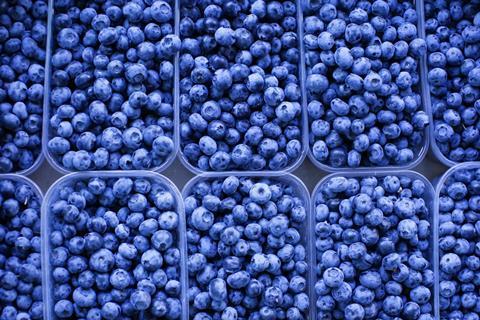RaboResearch’s latest blueberry market report reveals continued growth in global demand, with US per capita consumption exceeding 1.3kg annually and strong EU demand despite price volatility

Global demand for blueberries continues to rise, with North America and Europe leading the way.
That is according to the latest RaboResearch Blueberry Update 2025, a report covering the international market.
In the US, it said, annual per capita consumption now exceeds 1.3kg per capita and is still increasing.
Meanwhile, demand in the EU remains strong despite price volatility and inconsistent supply.
While China has already shown “significant growth” in both production and consumption, other Asian markets are also showing encouraging signs of demand.
In countries like India and Thailand, blueberry imports are still limited but growing, Rabobank explained.
To ensure that demand keeps pace with the rapidly expanding global supply, targeted marketing and consistent quality are described as “essential”.
“Global blueberry supply is expanding and becoming more diverse,” said David Magaña, senior food and agribusiness analyst at RaboResearch.
“Peru remains the largest supplier in South America, while Morocco is rapidly gaining ground in Africa and could eventually surpass Chile and Canada.
”Production in the US is stable, Canada is levelling off, and Mexico is under pressure to improve cost efficiency,” he continued.
”South America is seeing varietal innovation, whereas Europe faces challenges such as regulatory constraints.
”Meanwhile, China remains the largest producer and has started exporting,” he highlighted.
”These developments point to a more integrated global supply landscape, where scale, genetics, and logistics will determine future competitiveness.”
Blueberry consumption continues to grow in key markets, Magaña pointed out.
“There is still room for growth in the US. Overall demand is rising significantly and outpacing that of other fruits.
”The trend toward healthy snacking presents an opportunity for further demand growth in both established and emerging markets,” he urged.
”Over the past decade, US imports have increased substantially, while real prices have also edged up. This indicates that higher volumes are being absorbed without downward pressure on prices.”
According to Magaña, the European market holds even greater growth potential.
“However, ensuring sufficient availability and quality during certain times of the year remains a challenge,” he warned.
”At the same time, competition has intensified. Over the past decade, Peruvian blueberry exports to the EU have nearly quadrupled, and Morocco’s rapid growth could make it the second-largest exporter by the end of the decade, potentially overtaking Chile and Canada.
”However, Morocco’s continued growth will depend on the availability of critical production factors such as land, water, and labour – resources that are far from guaranteed,” Magaña commented.
”In the EU, rising costs and resource constraints are already limiting production growth.
”To capitalise on rising consumption in both established and emerging markets, such as those in the Asia-Pacific and the Middle East, producers and exporters worldwide must focus on improving quality, efficiency, and strategic marketing,” he added.



